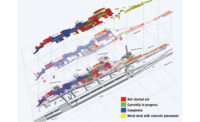A change is unfolding in how people interact with computers. We still cling to peripheral input-output devices and click, drag and print 2D information, but soon we mostly will talk with computers to interact and command. Hardin said that will lead to "better outputs and inputs, providing more data-rich information than in the past."
Hardin gave the example of an engineer verbally asking a computer to find the optimal pump for an installation in a powerplant. The computer researches and places a suggested pump in the design almost instantly. Yet Hardin does not see this as a threat to engineering and construction jobs. Rather, he sees it as "the next step in how we are going to become much more efficient as an industry."
The coming tools will enhance collaboration and do a better job of "analyzing our historical data so that we don't start each job from zero," added Anthony Colonna, Skanska USA Building's senior vice president of innovative construction solutions. A shift from rules-based software to systems that learn through observation, along with immersive technologies and handheld devices that let users interface fluidly with computers, is driving improvements, he added.
Colonna gave the example of bringing efficiency to today's jobsite, which he described as "organized chaos, at best," by tracking people and assets for greater visibility. "We will be able to make quick and dynamic changes to a schedule in real time," he said.
"We're not doing a good job of capturing best practices and institutional knowledge," added Sesh Commuri, a professor of electrical and computer engineering at the University of Oklahoma, Norman, "but machine learning can learn from our best practices and bring it seamlessly into our designs."
But attendees also were warned of cyber risks. While firms may think they are low on hackers' target lists, they may, in fact, be high-not for their own data, but for their customers', advised Michael Petrisko, senior vice president and CIO at Hill International. He cited the recent theft of Target Corp. data that investigators believe was enabled by access codes stolen from an HVAC contractor. "Who your clients are could be a critical concern," said Petrisko.
Risks include physical theft of equipment, such as internet hardware in a job trailer that may store addresses and passwords. Other risks include the increase of phishing attacks, which trick employees to click on dangerous links or voluntarily provide sensitive information.
Unfortunately, added John Jacobs, senior vice president and CIO at JE Dunn Construction Co., innovation in collaboration technology "flies in the face of security. Collaboration is inviting people you don't know to your data," he said. JE Dunn has 2,000 internal users on 800 project jobsites, but it has 30,000 external users, as well. "That's 30,000 people hitting data who I have no control over. Collaboration is an enormous, wrap-around risk," Jacobs said.
Jacobs added that construction firms have difficulty finding outside security experts to help protect their systems because the shifting partnerships required for construction are so much more complex and fluid than those of the security experts' usual clients, such as banks and retailers. But Reed Loden, director of security for Hackerone, a company that connects hacker security researchers with companies, gave attendees 12 security essentials. "Hackers are lazy. They go after the weakest link," Loden said.




Post a comment to this article
Report Abusive Comment